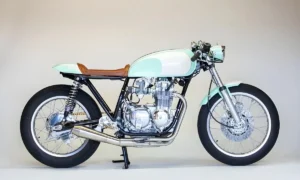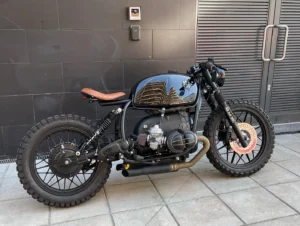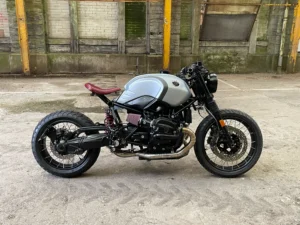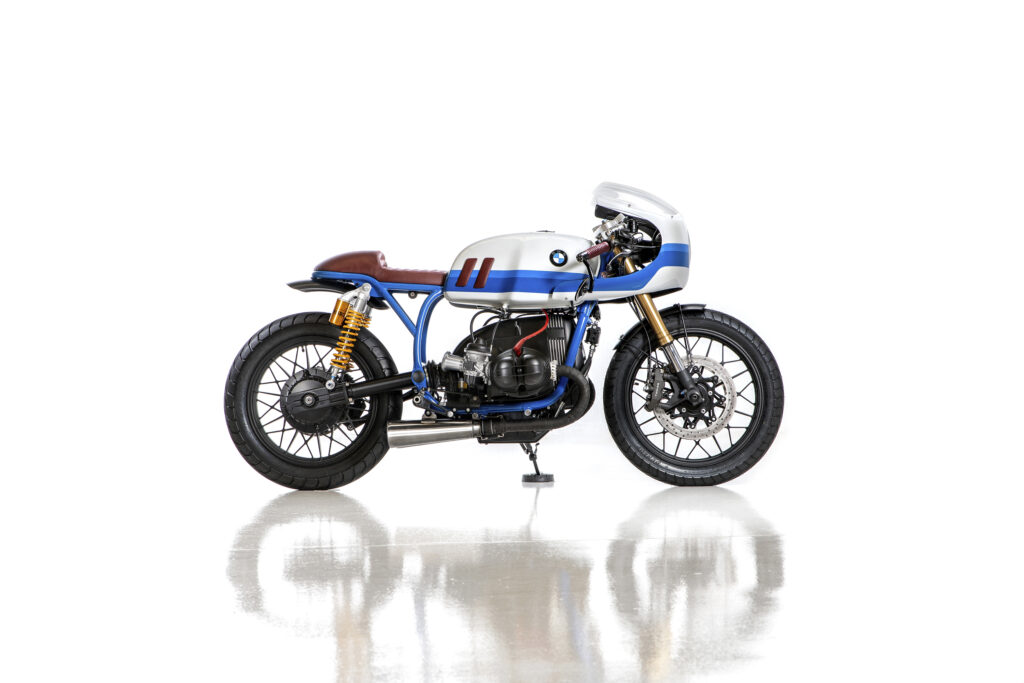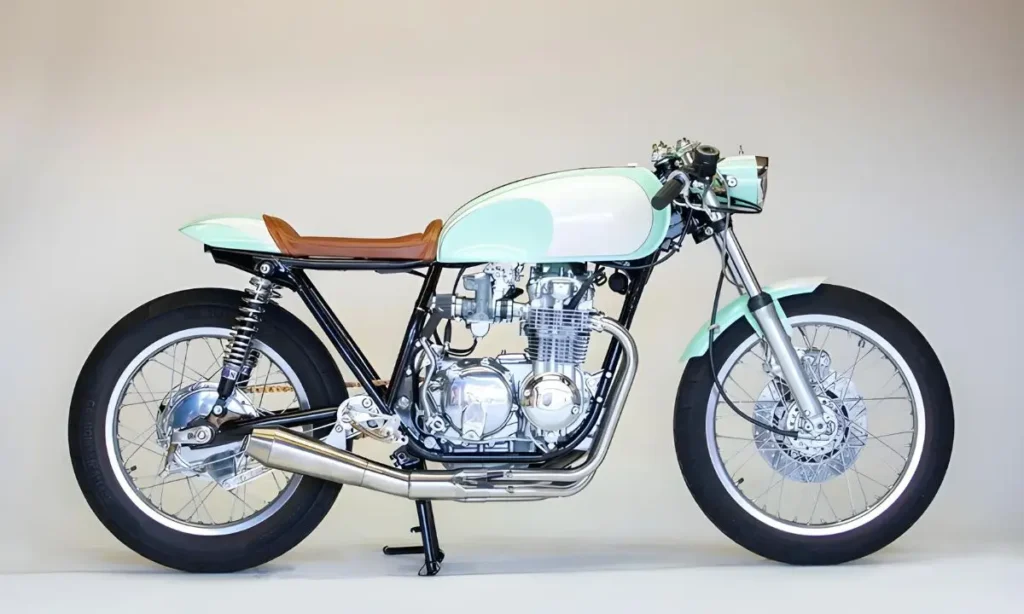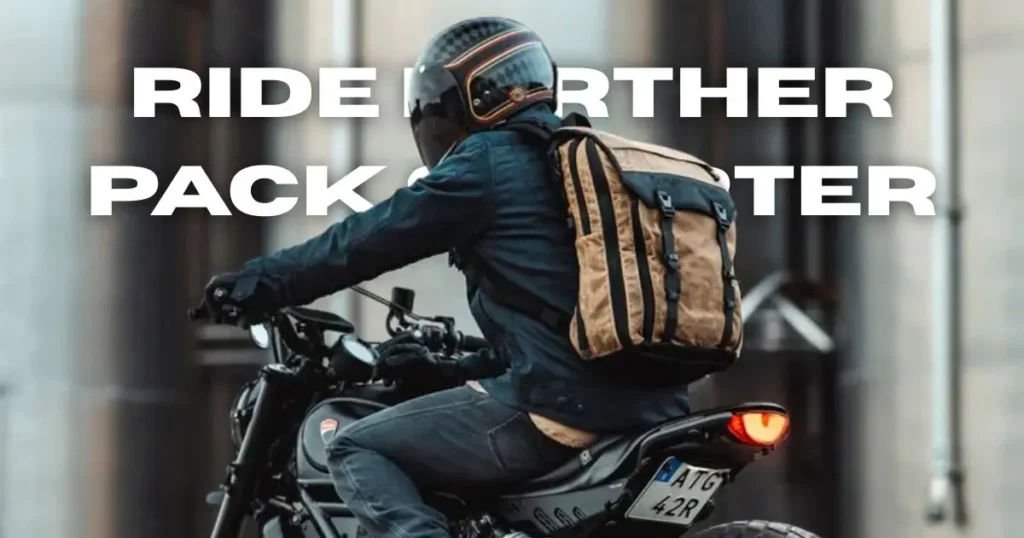Table of Contents
ToggleThe BMW R65 is a great motorcycle for building a café racer. It has a classic design and a solid reputation for reliability. Many riders love it because it offers the perfect mix of vintage charm and modern performance. It is not too large or heavy, which makes it easier to handle for custom projects.
Café racers are more than just motorcycles. They represent a style and a way of life. They focus on speed, simplicity, and a sleek design. Transforming a BMW R65 into a café racer lets you create something unique. You get to blend your personality with the bike’s classic features.
This guide will help you every step of the way. You don’t need to be a professional mechanic, but basic mechanical skills and patience are important. The right tools and guidance will help you succeed.
Planning and Preparation
Building a café racer starts with good planning. You need a clear idea of what you want. A simple plan makes the process easier and faster.
Research and Inspiration
Look at photos of other BMW R65 café racers. Search online or check motorcycle forums. Save the designs you like. Think about the style you want. Some bikes have a sleek and modern look. Others keep a vintage charm. Find what fits your taste and skills.
Setting a Budget
Building a café racer costs money. Decide how much you can spend. Include the cost of the bike, parts, and tools. Set aside some extra money for unexpected repairs. A clear budget helps you avoid overspending.
Workspace Arrangement
You need a safe and clean place to work. A garage or shed works well. Keep tools and parts organized. Good lighting is important. It helps you see small details. Arrange the space so you can move around the bike easily.
Acquiring the Donor Bike
The BMW R65 is a great base for a café racer project. It is reliable and has a timeless design. Before starting, you need to find the right bike to work on.
Selecting the Right R65
Not all BMW R65 motorcycles are the same. Some have been well cared for, while others need more work. Look for a bike with a clean title. This avoids legal issues later. Check the engine and frame for damage. Rust can be fixed, but it adds extra work.
Ask about the bike’s history. Find out how it was used and maintained. Low mileage is good, but regular maintenance is more important. Bikes with service records are easier to trust.
Initial Assessment
Inspect the bike carefully before buying it. Check the tires, brakes, and suspension. These parts wear out over time. Look for leaks around the engine and transmission. Test the electrical system. Turn on the lights and check the battery.
Take notes about what needs repair or replacement. This helps you plan the build better. Buying a bike in good condition saves time and money later.
Disassembly
Disassembling the bike is the first big step in the build. It lets you inspect each part closely. You can see what needs cleaning, repair, or replacement. A good teardown makes the rest of the project smoother.
Systematic Teardown
Start by removing large parts like the seat, fuel tank, and wheels. Then move to smaller components like cables, wiring, and controls. Keep all screws, nuts, and bolts in labeled containers. This avoids losing or mixing them up later.
Detach the engine and exhaust carefully. Use a jack or stand to support the bike during this process. Take your time with wiring. Old wires may be fragile and can break easily.
Documentation
Take photos of the bike before and during the teardown. Focus on how parts connect to each other. Label each part with tags or markers. Write down notes if needed. This will help when putting the bike back together.
Organize parts into groups. Keep electrical components, engine parts, and bodywork separate. A well-organized workspace saves time and reduces mistakes.
Frame Modification
The frame is the backbone of your café racer. Adjusting it changes the bike’s overall look and performance. This step is important for achieving the sleek and minimalist café racer style.
Subframe Alterations
Start by inspecting the original subframe. Most café racers need a shorter and simpler subframe. Remove the old one and design a new one that fits your seat and style. Weld the new subframe securely to the main frame. Ensure it aligns properly with the wheels.
Many builders use loop-style subframes. This design looks clean and supports a flat seat. Test the frame for strength after welding. It must hold the rider’s weight and stay stable during rides.
Frame Bracing
Older bikes like the R65 may need extra bracing. This improves stability and reduces flex during high speeds. Add braces at key stress points on the frame. Use high-quality steel for durability. Strong bracing ensures a safer ride.
Cleaning and Painting
Prepare the frame for painting. Sand off rust and old paint. Clean the surface thoroughly. Use a primer to prevent future rust. Powder coating is a popular option. It adds a durable and professional finish.
A well-prepped frame is the foundation of a good build. Neat and precise work here makes a big difference later.
Suspension and Wheels
Upgrading the suspension and wheels is key to improving performance. It also enhances the bike’s handling and overall look. A good suspension system makes the ride smoother and safer.
Front Fork Upgrades
The stock front forks on the BMW R65 work fine for regular use. For a café racer, you may need better ones. Modern forks offer improved handling and control. Many builders swap the original forks for inverted forks or forks from a sports bike. These upgrades improve stiffness and braking power.
Replace the fork oil and seals if the original forks are in good condition. Check for any signs of leaks or wear. Ensure the front suspension feels firm but not overly stiff.
Rear Suspension
The rear shocks also need attention. Café racers often use shorter shocks for a lower profile. You can install aftermarket shocks designed for better damping and comfort. Some builders opt for a monoshock conversion. This changes the look entirely and adds a modern touch.
Check the suspension alignment. Both front and rear systems should work together for balanced performance.
Wheel Selection
The wheels and tires define much of the café racer’s style. Spoke wheels are a classic choice. They match the vintage look of the BMW R65. Alloy wheels provide a more modern appearance.
Pick tires that balance grip and style. Many riders prefer vintage-styled tires with good road performance. Ensure the tires fit your chosen wheels and provide enough clearance with the frame and fenders.
Strong and reliable suspension and wheels make the bike safer and more enjoyable to ride. Focus on quality upgrades for long-term benefits.
Engine Overhaul
The engine is the heart of your café racer. A well-tuned engine ensures better performance and reliability. This step requires careful attention to detail.
Inspection and Rebuild
Start by inspecting the engine for wear and damage. Check the cylinders, pistons, and valves. Look for signs of oil leaks or carbon buildup. Replace worn-out parts with high-quality replacements.
Clean the engine thoroughly. Remove grease and dirt from all surfaces. A clean engine runs cooler and looks better. Rebuild the engine if necessary. Follow the service manual for torque settings and assembly order.
Performance Enhancements
Many café racer builders upgrade the engine for more power. Install high-performance carburetors for better fuel delivery. Mikuni or Dell’Orto carburetors are popular options. A free-flowing exhaust system improves airflow and adds a deep, rich sound.
Consider upgrading the air filter. Cone-style filters are simple and boost performance. Tune the engine after making these changes. Adjust the carburetors for smooth idling and quick throttle response.
Focus on reliability. An engine that runs well is more enjoyable than one with constant issues. Regular maintenance keeps the engine in top condition.
Electrical System
The electrical system is an important part of your café racer. A clean and simple setup improves reliability and makes the bike look better. This step requires care and attention.
Rewiring
Old wiring can cause problems. Remove the original harness and replace it with a new one. Keep the wiring simple. Use fewer wires to reduce clutter. Label each wire to avoid confusion during installation.
Add a modern fuse box. It protects the system from electrical issues. Use heat-shrink tubing to secure connections and prevent short circuits.
Lighting
Upgrade the lighting to match the café racer style. LED lights are a great option. They use less power and last longer. Install a round LED headlight for a classic look. Replace the turn signals and brake light with smaller, sleek models.
Check local regulations for lighting requirements. Make sure all lights are visible and work properly.
Instrumentation
Minimalism is key for a café racer. Replace the old gauges with a single speedometer or tachometer. Motogadget instruments are popular for their modern features and clean design. Mount the gauge on the handlebars for easy reading.
The electrical system connects everything on the bike. Keep it neat and reliable for a hassle-free ride.
Bodywork and Aesthetics
Bodywork gives your café racer its style. A sleek design makes the bike stand out. Focus on simple and clean lines for the best look.
Fuel Tank Selection
Pick a fuel tank that fits the frame and matches the café racer style. Many builders use a classic teardrop-shaped tank. Some prefer tanks from other models like the Honda Nighthawk. Test-fit the tank before mounting it. Ensure it clears the handlebars and doesn’t interfere with the frame.
Refinish the tank for a fresh look. Sand it down and apply primer. Use high-quality paint for durability. Add a clear coat for a shiny finish.
Seat Fabrication
A flat, single-seat design is popular for café racers. Make sure the seat fits the subframe and aligns with the tank. You can buy a pre-made seat or have one custom-made. Upholster the seat with leather or vinyl for comfort and style.
Add padding for a smooth ride. Match the seat color to the tank for a clean, coordinated look.
Fairings and Fenders
Decide whether you want fairings or leave the bike exposed. Small front fairings can add a sporty look. Use lightweight materials like fiberglass or aluminum. Keep them minimal to stay true to the café racer aesthetic.
Trim or replace the fenders. Shorter fenders look better on a café racer. They also reduce weight. Make sure they provide enough protection from road debris.
Paint and Finish
Pick a color scheme that matches your style. Classic colors like black, white, or metallic shades work well. Add simple graphics or stripes for a vintage touch. Use durable paint to protect the bike from scratches and weather.
Bodywork defines the bike’s personality. Take your time to get the details right.
Final Assembly
This is the stage where everything comes together. Assemble the bike carefully. Each part needs to fit perfectly for a safe and smooth ride.
Reconstruction
Start with the frame. Attach the subframe, suspension, and wheels. Tighten all bolts to the correct torque. Install the engine next. Ensure it aligns properly with the frame and mounts.
Add the fuel tank and seat. Connect the electrical system. Secure all wires and test the connections. Attach the handlebars, controls, and cables. Keep everything tight and organized.
Fluid Replacement
Fill the engine with fresh oil. Use high-quality oil recommended for the BMW R65. Replace the brake fluid with DOT-approved fluid. Add coolant if your bike has a liquid-cooled engine. Check all fluid levels twice to avoid problems later.
Safety Checks
Inspect the bike before the first ride. Test the brakes, lights, and controls. Check the tire pressure and alignment. Spin the wheels to make sure they move freely. Look for any loose bolts or parts.
A solid assembly ensures the bike is ready for the road. Double-check everything to avoid issues during the test ride.
Testing and Tuning
This is where the hard work pays off. Testing and tuning ensure the bike runs smoothly and performs well. Take your time with this step for the best results.
Initial Startup
Start the engine for the first time. Listen for unusual noises. Check for leaks around the engine, fuel tank, and exhaust. Let the engine warm up. Observe how it idles. Adjust the carburetors if the engine runs rough or stalls.
Test the throttle response. The engine should rev smoothly without hesitation. Shut off the engine and inspect all connections.
Road Testing
Take the bike for a short ride. Start slow and stay close to your workspace. Test the brakes and suspension. Make sure the bike handles well in corners. Listen for any rattles or vibrations.
Test the lighting and instruments while riding. All lights should work properly. The speedometer and other gauges should display accurate readings.
Fine-Tuning
Adjust the carburetors for optimal performance. Ensure the air-fuel mixture is correct. Check the spark plugs after the test ride. A light tan color on the plugs means the mixture is good.
Align the wheels and suspension if the bike feels unsteady. Tighten any loose bolts or connections. Repeat the test ride until everything feels perfect.
Testing and tuning make sure the bike is ready for daily use. It’s an important step for safety and performance.
Registration and Legalities
Once the bike is ready, you need to ensure it meets local laws. Proper registration and compliance make the bike legal and safe to ride on the road.
Compliance
Check local regulations for modified motorcycles. Some areas have rules about exhaust noise levels, lighting, and emissions. Inspect the bike to ensure it follows these rules. Install a baffle in the exhaust if it is too loud. Use DOT-approved tires, lights, and mirrors.
Test the horn and turn signals. They are often required for road use. Keep documents for aftermarket parts. You may need them to prove the bike meets safety standards.
Documentation
Update the bike’s registration. Go to your local motor vehicle office with all necessary papers. Bring the title, proof of insurance, and receipts for major modifications. Some areas may require a safety inspection.
Get insurance that covers custom motorcycles. Regular policies may not apply to heavily modified bikes. Inform your insurance company about all changes.
Legal registration protects you from fines and other issues. It also makes it easier to sell the bike in the future.
Maintenance and Care
Regular maintenance keeps your café racer running smoothly. Proper care ensures it looks and performs well for years.
Routine Checks
Inspect the bike before every ride. Check the tire pressure and look for signs of wear. Examine the brake pads and fluid levels. Test the lights and signals to ensure they work properly.
Clean the chain and adjust it as needed. A well-lubricated chain lasts longer and reduces wear on the sprockets. Tighten any loose bolts or screws.
Long-Term Maintenance
Follow a maintenance schedule based on the bike’s manual. Change the engine oil and filter regularly. Replace spark plugs and air filters as needed. Inspect the suspension and bearings for signs of wear.
Flush the brake fluid once a year. This prevents moisture buildup and keeps the brakes effective. Check the battery and charge it if necessary. Replace old wiring or connectors to avoid electrical issues.
Storage Tips
Store the bike in a dry, clean place. Use a cover to protect it from dust and moisture. Add a fuel stabilizer if storing it for a long time. Keep the tires off the ground with a stand to prevent flat spots.
Good maintenance extends the life of your bike. It also ensures a safe and enjoyable ride every time.
Conclusion
Building a BMW R65 café racer is a rewarding project. It takes effort, but the result is worth it. You create a bike that reflects your style and personality. Each step, from planning to the final ride, brings you closer to your dream motorcycle.
Stay organized and patient throughout the process. Follow this guide to make each step easier. Focus on quality parts and careful work. This ensures a safe and reliable bike.
Enjoy the process. Building a café racer is not just about the result. It is also about learning new skills and enjoying the journey. Ride your finished bike with pride, knowing you built it with your own hands.
Disclaimer
This guide is for informational purposes only. Building a café racer involves working with tools, engines, and electrical systems. These activities can be dangerous if done incorrectly. Always use proper tools and safety equipment. Follow local laws and regulations about motorcycle modifications.
Work within your skill level. Seek help from a professional mechanic for complex tasks. Incorrect assembly can lead to accidents or damage to the bike. The author is not responsible for injuries, accidents, or damages that may occur during your project.
Your safety is your responsibility. Take your time and work carefully. Always prioritize safety over speed.
FAQs
How much does it cost to build a BMW R65 café racer?
The cost varies based on parts and labor. On average, expect to spend between $3,000 and $10,000.
How long does it take to complete the build?
The timeline depends on your experience and available time. Typically, it takes 3 to 6 months.
Do I need special tools for this project?
Basic mechanical tools are necessary. Specialized tools may be required for specific tasks.
Can I use parts from other BMW models?
Is it legal to modify my BMW R65?
Modifications are generally legal. However, check local laws to ensure compliance.
How can I improve the bike’s performance?
Upgrading the exhaust, carburetors, and suspension enhances performance. Regular maintenance is also crucial.
What type of fuel should I use after modifications?
Use high-octane fuel to optimize engine performance and efficiency.
How often should I service my café racer?
Regular servicing every 3,000 miles or annually is recommended. This ensures longevity and reliability.



